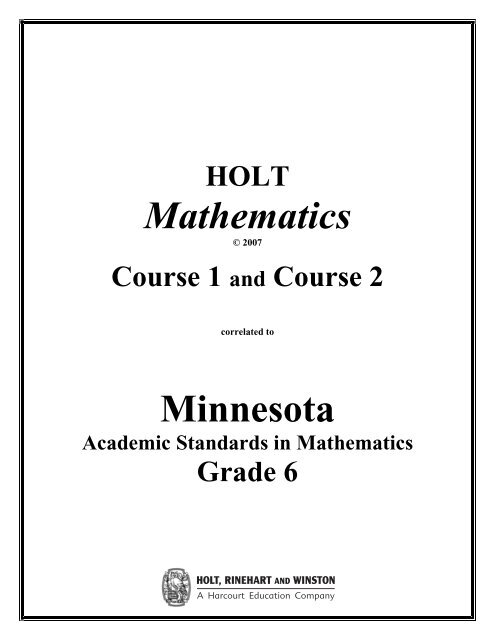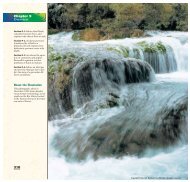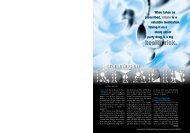Holt Mathematics Course 1 and Course 2 Correlation to Grade 6 ...
Holt Mathematics Course 1 and Course 2 Correlation to Grade 6 ...
Holt Mathematics Course 1 and Course 2 Correlation to Grade 6 ...
Create successful ePaper yourself
Turn your PDF publications into a flip-book with our unique Google optimized e-Paper software.
HOLT<br />
<strong>Mathematics</strong><br />
© 2007<br />
<strong>Course</strong> 1 <strong>and</strong> <strong>Course</strong> 2<br />
correlated <strong>to</strong><br />
Minnesota<br />
Academic St<strong>and</strong>ards in <strong>Mathematics</strong><br />
<strong>Grade</strong> 6
Explanation of <strong>Correlation</strong><br />
The following document is a correlation of <strong>Holt</strong> <strong>Mathematics</strong>, <strong>Course</strong> 1 <strong>and</strong> <strong>Course</strong> 2<br />
<strong>to</strong> the April 14, 2007 Revision of the Minnesota Academic St<strong>and</strong>ards in <strong>Mathematics</strong>,<br />
<strong>Grade</strong> 6. The correlation provides a cross-reference between the skills in the st<strong>and</strong>ards<br />
<strong>and</strong> representative page numbers where those skills are taught or assessed.<br />
The references contained in this correlation reflect the interpretation by <strong>Holt</strong>, Rinehart<br />
<strong>and</strong> Wins<strong>to</strong>n of the objectives outlined in the Minnesota Academic St<strong>and</strong>ards in<br />
<strong>Mathematics</strong>.<br />
<strong>Correlation</strong> prepared September 2007
<strong>Grade</strong> 6 Minnesota Academic<br />
St<strong>and</strong>ards in <strong>Mathematics</strong><br />
<strong>Holt</strong> <strong>Mathematics</strong><br />
<strong>Course</strong> 1<br />
1<br />
HOLT, RINEHART AND WINSTON<br />
<strong>Holt</strong> <strong>Mathematics</strong>,<br />
<strong>Course</strong> 2<br />
STRAND NUMBER & OPERATION<br />
St<strong>and</strong>ard Read, write, represent <strong>and</strong> compare positive rational numbers expressed as fractions,<br />
decimals, percents <strong>and</strong> ratios; write positive integers as products of fac<strong>to</strong>rs; use these<br />
representations in real-world <strong>and</strong> mathematical situations.<br />
6.1.1.1 Locate positive rational numbers<br />
on a number line <strong>and</strong> plot pairs<br />
of positive rational numbers on a<br />
coordinate grid.<br />
6.1.1.2 Compare positive rational<br />
numbers represented in various<br />
forms. Use the symbols < <strong>and</strong> >.<br />
6.1.1.3 Underst<strong>and</strong> that percent<br />
represents parts out of 100 <strong>and</strong><br />
ratios <strong>to</strong> 100.<br />
6.1.1.4 Determine equivalences among<br />
fractions, decimals <strong>and</strong> percents;<br />
select among these<br />
representations <strong>to</strong> solve<br />
problems.<br />
6.1.1.5 Fac<strong>to</strong>r whole numbers; express a<br />
whole number as a product of<br />
prime fac<strong>to</strong>rs with exponents.<br />
6.1.1.6 Determine greatest common<br />
fac<strong>to</strong>rs <strong>and</strong> least common<br />
multiples. Use common fac<strong>to</strong>rs<br />
<strong>and</strong> common multiples <strong>to</strong> do<br />
arithmetic with fractions <strong>and</strong> find<br />
equivalent fractions.<br />
6.1.1.7 Convert between equivalent<br />
representations of positive<br />
rational numbers.<br />
Lesson 1.1 (7) Lesson 2.1 (76-79)<br />
Lesson 4.1 (224-227)<br />
Lesson 1.1 (6-9)<br />
Lesson 3.1 (108-111)<br />
Lesson 4.7 (198-201)<br />
Lesson 2.11 (128-131)<br />
Lesson 7.7 (381-384) Lesson 6.1 (330-332)<br />
Lesson 4.4 (181-184)<br />
Lesson 7.8 (385-388)<br />
Lesson 2.9 (120-123)<br />
Lesson 2.10 (124-127)<br />
Lesson 6.2 (333-335)<br />
Lesson 4.2 (169-172) Lesson 2.6 (106-107)<br />
Lesson 4.3 (173-176) Lesson 2.7 (110-113)<br />
Lesson 2.8 (114-117)<br />
Lesson 4.4 (181-184)<br />
Lesson 7.8 (385-388)<br />
Lesson 2.9 (120-123)<br />
Lesson 2.10 (124-127)<br />
Lesson 6.2 (333-335)<br />
St<strong>and</strong>ard Underst<strong>and</strong> the concept of ratio <strong>and</strong> its relationship <strong>to</strong> fractions <strong>and</strong> <strong>to</strong> the<br />
multiplication <strong>and</strong> division of whole numbers. Use ratios <strong>to</strong> solve real-world <strong>and</strong><br />
mathematical problems.<br />
6.1.2.1 Identify <strong>and</strong> use ratios <strong>to</strong><br />
compare quantities; underst<strong>and</strong><br />
that comparing quantities using<br />
ratios is not the same as<br />
comparing quantities using<br />
subtraction.<br />
6.1.2.2 Apply the relationship between<br />
ratios, equivalent fractions <strong>and</strong><br />
percents <strong>to</strong> solve problems in<br />
various contexts, including those<br />
involving mixtures <strong>and</strong><br />
concentrations.<br />
Lesson 7.1 (352-355)<br />
Lesson 7.2 (356-359)<br />
Lesson 4.5 (186-189)<br />
Lesson 7.1 (352-355)<br />
Lesson 7.8 (385-388)<br />
Lesson 5.1 (270-273)<br />
Lesson 5.4 (283-285)<br />
Lesson 2.9 (120-123)<br />
Lesson 2.10 (124-127)<br />
Lesson 5.1 (270-273)<br />
Lesson 5.2 (274-277)<br />
Lesson 5.4 (283-286)<br />
Lesson 6.2 (333-335)<br />
Lesson 6.4 (342-345)<br />
Lesson 6.5 (346-349)<br />
Lesson 6.6 (352-355)<br />
Lesson 6.7 (356-359)
<strong>Grade</strong> 6 Minnesota Academic<br />
St<strong>and</strong>ards in <strong>Mathematics</strong><br />
6.1.2.3 Determine the rate for ratios of<br />
quantities with different units.<br />
6.1.2.4 Use reasoning about<br />
multiplication <strong>and</strong> division <strong>to</strong><br />
solve ratio <strong>and</strong> rate problems.<br />
<strong>Holt</strong> <strong>Mathematics</strong><br />
<strong>Course</strong> 1<br />
2<br />
HOLT, RINEHART AND WINSTON<br />
<strong>Holt</strong> <strong>Mathematics</strong>,<br />
<strong>Course</strong> 2<br />
Lesson 7.1 (352-355) Lesson 5.2 (274-277)<br />
Lesson 7.1 (352-355)<br />
Lesson 7.2 (356-359)<br />
Lesson 5.1 (270-273)<br />
Lesson 5.2 (274-276)<br />
St<strong>and</strong>ard Multiply <strong>and</strong> divide decimals, fractions <strong>and</strong> mixed numbers; solve real-world <strong>and</strong><br />
mathematical problems using arithmetic with positive rational numbers.<br />
6.1.3.1 Multiply <strong>and</strong> divide decimals <strong>and</strong><br />
fractions, using efficient <strong>and</strong><br />
generalizable procedures,<br />
including st<strong>and</strong>ard algorithms.<br />
6.1.3.2 Use the meanings of fractions,<br />
multiplication, division <strong>and</strong> the<br />
inverse relationship between<br />
multiplication <strong>and</strong> division <strong>to</strong><br />
make sense of procedures for<br />
multiplying <strong>and</strong> dividing<br />
fractions.<br />
6.1.3.3 Calculate the percent of a<br />
number <strong>and</strong> determine what<br />
percent one number is of another<br />
number <strong>to</strong> solve problems in<br />
various contexts.<br />
6.1.3.4 Solve real-world <strong>and</strong><br />
mathematical problems requiring<br />
arithmetic with decimals,<br />
fractions <strong>and</strong> mixed numbers.<br />
6.1.3.5 Estimate solutions <strong>to</strong> problems<br />
with whole numbers, fractions<br />
<strong>and</strong> decimals <strong>and</strong> use the<br />
estimations <strong>to</strong> assess the<br />
reasonableness of computations<br />
<strong>and</strong> of results in the context of<br />
the problem.<br />
Lesson 3.5 (130-133)<br />
Lesson 3.6 (134-136)<br />
Lesson 3.7 (137-140)<br />
Lesson 5.6 (254-257)<br />
Lesson 5.7 (260-263)<br />
Lesson 5.8 (264-267)<br />
Lesson 5.9 (270-273)<br />
Lesson 5.7 (260-263)<br />
Lesson 5.8 (264-267)<br />
Lesson 5.9 (270-273)<br />
Lesson 5.10 (274, 277)<br />
Lesson 3.3 (160-163)<br />
Lesson 3.4 (166-169)<br />
Lesson 3.5 (170-173)<br />
Lesson 3.10 (196-199)<br />
Lesson 3.11 (200-203)<br />
Lesson 3.10 (196-199)<br />
Lesson 3.11 (200-203)<br />
Lesson 7.10 (394-397) Lesson 6.4 (342-345)<br />
Lesson 6.5 (346-349)<br />
Lesson 6.6 (352-355)<br />
Lesson 6.7 (356-359)<br />
Lesson 3.3 (118-121)<br />
Lesson 3.5 (130-133)<br />
Lesson 3.6 (134-136)<br />
Lesson 3.7 (137-140)<br />
Lesson 3.8 (141-143)<br />
Lesson 3.9 (144-147)<br />
Lesson 4.8 (202-205)<br />
Lesson 4.9 (206-209)<br />
Lesson 5.2 (234-237)<br />
Lesson 5.3 (238-241)<br />
Lesson 5.4 (244-247)<br />
Lesson 1.2 (10-13)<br />
Lesson 3.2 (112-115)<br />
Lesson 4.9 (206-209)<br />
Lesson 3.2 (154-157)<br />
Lesson 3.3 (160-163)<br />
Lesson 3.4 (166-169)<br />
Lesson 3.5 (170-173)<br />
Lesson 3.6 (174-177)<br />
Lesson 3.7 (180-183)<br />
Lesson 3.8 (186-189)<br />
Lesson 3.9 (190-193)<br />
Lesson 3.10 (196-199)<br />
Lesson 3.11 (200-203)<br />
Lesson 3.12 (204-207)<br />
Lesson 3.1 (150-153)<br />
Lesson 3.7 (180-183)
<strong>Grade</strong> 6 Minnesota Academic<br />
St<strong>and</strong>ards in <strong>Mathematics</strong><br />
<strong>Holt</strong> <strong>Mathematics</strong><br />
<strong>Course</strong> 1<br />
3<br />
HOLT, RINEHART AND WINSTON<br />
<strong>Holt</strong> <strong>Mathematics</strong>,<br />
<strong>Course</strong> 2<br />
STRAND ALGEBRA<br />
St<strong>and</strong>ard Recognize <strong>and</strong> represent relationships between varying quantities; translate from one<br />
representation <strong>to</strong> another; use patterns, tables, graphs <strong>and</strong> rules <strong>to</strong> solve real-world<br />
<strong>and</strong> mathematical problems.<br />
6.2.1.1 Underst<strong>and</strong> that a variable can be<br />
used <strong>to</strong> represent a quantity that<br />
can change, often in relationship<br />
<strong>to</strong> another changing quantity.<br />
Use variables in various<br />
contexts.<br />
6.2.1.2 Represent the relationship<br />
between two varying quantities<br />
with function rules, graphs <strong>and</strong><br />
tables; translate between any two<br />
of these representations.<br />
Lesson 2.1 (54-57)<br />
Lesson 2.2 (58-61)<br />
Lesson 2.3 (62-65)<br />
Lesson 2.4 (70-73)<br />
Lesson 11.9 (640-643)<br />
Lesson 11.10 (646-649)<br />
Lesson 1.7 (34-37)<br />
Lesson 1.8 (38-41)<br />
Lesson 4.6 (248-251)<br />
Lesson 12.3 (686-689)<br />
Lesson 4.2 (228-231)<br />
Lesson 4.4 (238-241)<br />
Lesson 4.5 (242-245)<br />
St<strong>and</strong>ard Use properties of arithmetic <strong>to</strong> generate equivalent numerical expressions <strong>and</strong><br />
evaluate expressions involving positive rational numbers.<br />
6.2.2.1 Apply the associative,<br />
commutative <strong>and</strong> distributive<br />
properties <strong>and</strong> order of<br />
operations <strong>to</strong> generate equivalent<br />
expressions <strong>and</strong> <strong>to</strong> solve<br />
problems involving positive<br />
rational numbers.<br />
Lesson 1.4 (22-25)<br />
Lesson 1.5 (26-29)<br />
Lesson 1.5 (23-26)<br />
Lesson 1.6 (28-31)<br />
Lesson 1.7 (34-37)<br />
Lesson 1.9 (42-45)<br />
Lesson 1.10 (46-49)<br />
Lesson 1.11 (52-55)<br />
Lesson 1.12 (56-59)<br />
Lesson 12.2 (682-685)<br />
St<strong>and</strong>ard Underst<strong>and</strong> <strong>and</strong> interpret equations <strong>and</strong> inequalities involving variables <strong>and</strong> positive<br />
rational numbers. Use equations <strong>and</strong> inequalities <strong>to</strong> represent real-world <strong>and</strong><br />
mathematical problems; use the idea of maintaining equality <strong>to</strong> solve equations.<br />
Interpret solutions in the original context.<br />
6.2.3.1 Represent real-world or<br />
mathematical situations using<br />
equations <strong>and</strong> inequalities<br />
involving variables <strong>and</strong> positive<br />
rational numbers.<br />
6.2.3.2 Solve equations involving<br />
positive rational numbers using<br />
number sense, properties of<br />
arithmetic <strong>and</strong> the idea of<br />
maintaining equality on both<br />
sides of the equation. Interpret a<br />
solution in the original context<br />
<strong>and</strong> assess the reasonableness of<br />
results.<br />
Lesson 2.4 (70-73)<br />
Lesson 2.5 (74-77)<br />
Lesson 2.6 (78-80)<br />
Lesson 2.7 (81-84)<br />
Lesson 2.8 (85-87)<br />
Lesson 3.9 (144-147)<br />
Lesson 5.5 (248-251)<br />
Lesson 5.10 (274-277)<br />
Lesson 2.4 (70-73)<br />
Lesson 2.5 (74-77)<br />
Lesson 2.6 (78-80)<br />
Lesson 2.7 (81-84)<br />
Lesson 2.8 (85-87)<br />
Lesson 3.9 (144-147)<br />
Lesson 5.5 (248-251)<br />
Lesson 5.10 (274-277)<br />
Lesson 1.10 (46-49)<br />
Lesson 1.11 (52-55)<br />
Lesson 1.12 (56-59)<br />
Lesson 3.6 (174-177)<br />
Lesson 3.12 (204-207)<br />
Lesson 12.1 (678-681)<br />
Lesson 12.2 (682-685)<br />
Lesson 12.3 (686-689)<br />
Lesson 12.5 (696-699)<br />
Lesson 12.6 (700-703)<br />
Lesson 12.7 (704-707)<br />
Lesson 1.10 (46-49)<br />
Lesson 1.11 (52-55)<br />
Lesson 1.12 (56-59)<br />
Lesson 3.6 (174-177)<br />
Lesson 3.12 (204-207)<br />
Lesson 12.1 (678-681)<br />
Lesson 12.2 (682-685)<br />
Lesson 12.3 (686-689)
<strong>Grade</strong> 6 Minnesota Academic<br />
St<strong>and</strong>ards in <strong>Mathematics</strong><br />
<strong>Holt</strong> <strong>Mathematics</strong><br />
<strong>Course</strong> 1<br />
4<br />
HOLT, RINEHART AND WINSTON<br />
<strong>Holt</strong> <strong>Mathematics</strong>,<br />
<strong>Course</strong> 2<br />
STRAND GEOMETRY & MEASUREMENT<br />
St<strong>and</strong>ard Calculate perimeter, area, surface area <strong>and</strong> volume of two- <strong>and</strong> three-dimensional<br />
figures <strong>to</strong> solve real-world <strong>and</strong> mathematical problems.<br />
6.3.1.1 Calculate the surface area <strong>and</strong><br />
volume of prisms <strong>and</strong> use<br />
appropriate units, such as cm2<br />
<strong>and</strong> cm3. Justify the formulas<br />
used. Justification may involve<br />
decomposition, nets or other<br />
models.<br />
6.3.1.2 Calculate the area of<br />
quadrilaterals. Quadrilaterals<br />
include squares, rectangles,<br />
rhombuses, parallelograms,<br />
trapezoids <strong>and</strong> kites. When<br />
formulas are used, be able <strong>to</strong><br />
explain why they are valid.<br />
Lesson 10.7 (572-575)<br />
Lesson 10.9 (582-585)<br />
Lesson 10.2 (586-589)<br />
Lesson 10.4 (597-601)<br />
Lesson 10.2 (546-549) Lesson 9.3 (530-533)<br />
Lesson 9.4 (534-537)<br />
Lesson 9.7 (550-553)<br />
6.3.1.3 Estimate the perimeter <strong>and</strong> area<br />
of irregular figures on a grid<br />
when they cannot be<br />
decomposed in<strong>to</strong> common<br />
figures <strong>and</strong> use correct units,<br />
such as cm <strong>and</strong> cm2.<br />
Lesson 10.1 (542-545) Lesson 9.6 (542-545)<br />
St<strong>and</strong>ard Underst<strong>and</strong> <strong>and</strong> use relationships between angles in geometric figures.<br />
6.3.2.1 Solve problems using the<br />
relationships between the angles<br />
formed by intersecting lines.<br />
Lesson 8.3 (424-427) Lesson 8.3 (452-455)<br />
6.3.2.2 Determine missing angle<br />
measures in a triangle using the<br />
fact that the sum of the interior<br />
angles of a triangle is 180°. Use<br />
models of triangles <strong>to</strong> illustrate<br />
this fact.<br />
6.3.2.3 Develop <strong>and</strong> use formulas for the<br />
sums of the interior angles of<br />
polygons by decomposing them<br />
in<strong>to</strong> triangles.<br />
St<strong>and</strong>ard Choose appropriate units of<br />
measurement <strong>and</strong> use ratios <strong>to</strong><br />
convert within measurement<br />
systems <strong>to</strong> solve real-world <strong>and</strong><br />
mathematical problems.<br />
6.3.3.1 Solve problems in various<br />
contexts involving conversion of<br />
weights, capacities, geometric<br />
measurements <strong>and</strong> times within<br />
measurement systems using<br />
appropriate units.<br />
6.3.3.2 Estimate weights, capacities <strong>and</strong><br />
geometric measurements using<br />
benchmarks in measurement<br />
systems with appropriate units.<br />
Technology Lab 8-5<br />
(441)<br />
Lesson 9.3 (496-500)<br />
Lesson 9.4 (501-503)<br />
Lesson 8.8 (478-481)<br />
Lesson 8.8 (478-481)<br />
Lesson 3.8 (189)<br />
Lesson 5.6 (292-295)<br />
Student H<strong>and</strong>book (770)
<strong>Grade</strong> 6 Minnesota Academic<br />
St<strong>and</strong>ards in <strong>Mathematics</strong><br />
<strong>Holt</strong> <strong>Mathematics</strong><br />
<strong>Course</strong> 1<br />
5<br />
HOLT, RINEHART AND WINSTON<br />
<strong>Holt</strong> <strong>Mathematics</strong>,<br />
<strong>Course</strong> 2<br />
STRAND DATA ANALYSIS & PROBABILITY<br />
St<strong>and</strong>ard Use probabilities <strong>to</strong> solve real-world <strong>and</strong> mathematical problems; represent<br />
probabilities using fractions, decimals <strong>and</strong> percents.<br />
6.4.1.1 Determine the sample space (set<br />
of possible outcomes) for a given<br />
experiment <strong>and</strong> determine which<br />
members of the sample space are<br />
related <strong>to</strong> certain events. Sample<br />
space may be determined by the<br />
use of tree diagrams, tables or<br />
pic<strong>to</strong>rial representations.<br />
Lesson 12.2 (672-675) Lesson 11.3 (636-639)<br />
6.4.1.2 Determine the probability of an Lesson 12.1 (668-671) Lesson 11.1 (628-631)<br />
event using the ratio between the Lesson 12.2 (673-675) Lesson 11.2 (632-635)<br />
size of the event <strong>and</strong> the size of<br />
the sample space; represent<br />
probabilities as percents,<br />
fractions <strong>and</strong> decimals between 0<br />
<strong>and</strong> 1 inclusive. Underst<strong>and</strong> that<br />
probabilities measure likelihood.<br />
Lesson 12.4 (682-685)<br />
6.4.1.3 Perform experiments for<br />
situations in which the<br />
probabilities are known, compare<br />
the resulting relative frequencies<br />
with the known probabilities;<br />
know that there may be<br />
differences.<br />
Lesson 12.2 (672-675)<br />
6.4.1.4 Calculate experimental<br />
probabilities from experiments;<br />
represent them as percents,<br />
fractions <strong>and</strong> decimals between 0<br />
<strong>and</strong> 1 inclusive. Use<br />
experimental probabilities <strong>to</strong><br />
make predictions when actual<br />
probabilities are unknown.<br />
Lesson 12.2 (672-675) Lesson 11.2 (632-635)

















